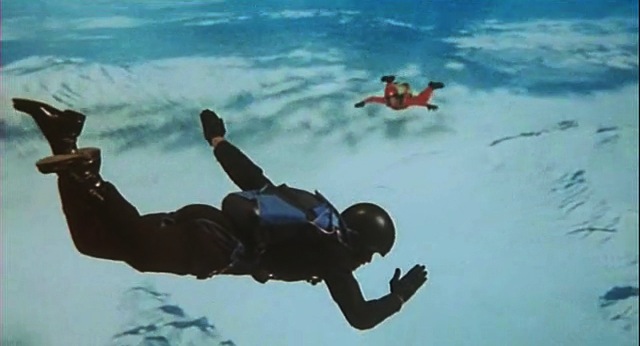B-MOVIE BULLSH*T - Part Nine "Deeds Not Words (Or Deeds)"
 Saturday, November 5, 2011 at 6:00AM
Saturday, November 5, 2011 at 6:00AM B-Movie Bullsh*t
Part Nine
Megaforce
(1982)
Synopsis
The desert country of Something-or-other (seriously, the geography of this movie is completely fucked) is under siege by a military dude named Duke Guerera. Without any other option to stop him, the attractive Major Zara and prissy General Edward Byrne-White turn to the world’s best last defense—Megaforce! Secretly funded by each of the world’s free nations, Megaforce only accepts the best of the world's best, which apparently includes a redneck named Dallas, and a bunch of ethic folks who aren’t given enough screen time to show any discernable personality (except for the Shakespeare quoting, Vivaldi listening, Rubic’s Cube solving African-American member, who’s rejection of traditional black stereotypical behaviour is obviously meant to be hilarious). We’re told that there are no ranks in Megaforce, everyone is equal save for the commander, Ace Hunter, who happens to have a history with Guerera. Ace and Zara quickly grow fond of each other, and even though she proves herself to be worthy of joining Megaforce, he refuses to allow her to accompany them on the raid against Guerera. The Zara-less raid appears to have been successful, but Megaforce learns that if they attempt to leave Something-or-other by land, their crossing the border will be considered an act of war by Someone-who-can-declare-such-things. This leaves the dried lakebed as the only place their bombers can land and pick them up, but Guerera is there waiting for them. In order to live to see another day, the good ole’ boys of Megaforce are going to have to do some quick thinking and extra cool motorcycle riding!
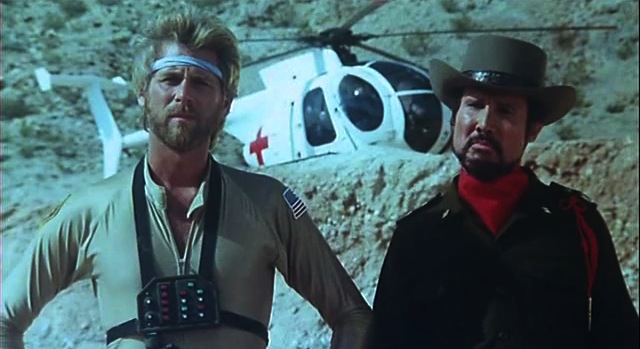
If you read the above synopsis you might have reasonably felt that I left something out—mainly an actual plot capable of sustaining a 96-minute movie. You’re not alone. When I finished revisiting Megaforce—which I hadn’t seen in its entirety in decades—I was shocked by how little story had actually been told. The entire movie breaks down into the following acts:
Act One – We’re introduced to Megaforce.
Act Two – Megaforce completes a four-minute mission (there’s an actual timer on the screen when this happens).
Act Three – Megaforce escapes from the bad guy’s country (without actually accomplishing anything beyond killing the guys in that one four-minute mission).
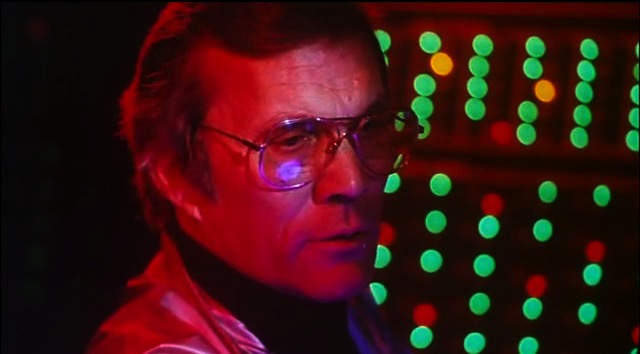 The brainchild of stuntman-turned-director Hal Needham, Megaforce is what happens when a man utterly devoid of self-awareness or irony is allowed to become a major force in Hollywood. There’s a picture in his recent autobiography (which I dissected at length at Bookgasm) of an ad he took out after the opening of Smokey and the Bandit II, in which he’s shown sitting on a wheelbarrow filled with money, clad in a collared shit, unbuttoned to expose his hairy chest and gold chains.
The brainchild of stuntman-turned-director Hal Needham, Megaforce is what happens when a man utterly devoid of self-awareness or irony is allowed to become a major force in Hollywood. There’s a picture in his recent autobiography (which I dissected at length at Bookgasm) of an ad he took out after the opening of Smokey and the Bandit II, in which he’s shown sitting on a wheelbarrow filled with money, clad in a collared shit, unbuttoned to expose his hairy chest and gold chains.
So, yeah, he was a major asshole, but—as the comical wheelbarrow full of cash would suggest—he was a successful asshole. Prior to Megaforce he had managed to catch the interest of a public weary of 70s cinematic innovation with the two Smokey and the Bandit movies, Hooper, and The Cannonball Run. Most canny observers, however, would note that these four films all had something besides Needham in common—star Burt Reynolds. In fact, Needham’s lone failure up to that point had been The Villain, a Western comedy made in the style of the Chuck Jones Warner Brothers cartoons, which Reynolds took a pass on. Clearly, Needham’s career depended on the patronage of his good friend and former housemate.
 And even though Needham lacked introspection, he clearly wasn’t an idiot. Watching Megaforce it becomes painfully obvious that he developed it as another Reynolds vehicle. The moments that actually come closest to working in the film are the light comic exchanges Ace shares with Zara, Dallas and--strangely--the villainous Duke, in which Reynolds onscreen voice screams out so loud it rattles your back molars.
And even though Needham lacked introspection, he clearly wasn’t an idiot. Watching Megaforce it becomes painfully obvious that he developed it as another Reynolds vehicle. The moments that actually come closest to working in the film are the light comic exchanges Ace shares with Zara, Dallas and--strangely--the villainous Duke, in which Reynolds onscreen voice screams out so loud it rattles your back molars.
But, as he had been with The Villain, Reynolds appears to have been smart enough to recognize a disaster in the making. This is pure speculation on my part, however, since Megaforce rates only the following mention in Needham's book:
The first time I was supposed to meet with Al Ruddy, who produced my Cannonball Run movies and Megaforce, was at Nate & Al’s, in Beverly Hills.
So the actual development and production history of the film are completely unknown to me. That said, Needham is not what anyone would call a closed book. Given what we know about him, the whys and the hows of the film aren’t at all difficult to imagine.
For example, it’s abundantly clear that the main reason Megaforce exists is because of Needham’s raging, rock hard boner for anything with an internal combustion engine. In fact, the cost of the machinery on display in the film is the only possible explanation for its $20 million budget, which sounds like nothing today, but was an extremely significant investment in 1982, especially for a film with no significant above the line costs.
The problem is that Needham clearly wanted cars and cycles that he could ride around on himself, which meant that none of the fantastic futuristic fighting vehicles look all that fantastic or futuristic. The one time in Needham’s career where he demanded some measure of verisimilitude was in the one project where an utter disregard for reality would have been most appropriate.
As someone who has absolutely no interest in motorized vehicles, I’m not the right judge when it comes to determining the awesomeness of Megaforce’s gas-fueled raison d’etres, but I do know that despite clearly being designed with toy shelves in mind, I didn’t know any kids who played with Megaforce toys in 1982. This link to images of the toy line, does an excellent job of explaining why. The fact that they felt compelled to release a toy version of the fucking pickup truck that Dallas and hilariously-educated-black-dude pick up the Major and General with is seriously messing with my brain.
To my eyes, the cars, trucks, and cycles, look like nothing more than expensively retooled cars, trucks, and cycles, which by itself does not a movie make. Ruddy and Needham (who both receive screenplay credits along with Bob Kachler, James Whittaker, and Andre Morgan—yes, Megaforce has five credited writers) try to make them seem cooler than cool by adding lasers and special paint jobs that do this:
But the lasers are barely used and the special paint thingee is never brought up again after Dallas demonstrates it (clearly none of the five writers are up on their Chekov). And, beyond the cars, the rest of the film barely rises above that of a TV movie. One reason it's impossible to figure out the film’s geography (beyond the incoherent screenplay) is the fact that the entire film was obviously shot in the same desert location, which just happened to be right next to Las Vegas, Nevada. (I’m guessing the decision to shoot there might have been connected to Needham’s deserved reputation as a dude who loved to par-tay!) Megaforce’s base is nothing more than a few large rooms and an unconvincing matte painting. And the non-driving effects range from the cheesy to the infamously hilarious.
The result is a very expensive film that looks little different than similar projects made with a tenth of Needham’s budget. It doesn’t help that Needham films with the eyes of a stuntman, not a director. Many of the stunts in the film are presented as events, rather than as part of the overall narrative. Personally knowing how difficult they are to pull-off, he isn’t able to cut them apart like a better filmmaker would.
Of course, none of this would matter if Megaforce had an exciting story filled with interesting characters, so the fact that it doesn’t is the true source of its failure. I’ve already described the film’s strange lack of story—it ends at what would be the halfway point of a modern action film—but the cast and characters also deserve some attention.
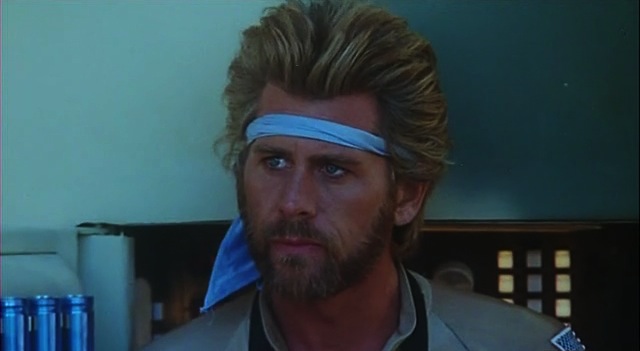 Unable to lure Reynolds into their trap, Ruddy and Needham went a fascinatingly different direction. Seven years had passed since Barry Bostwick had played Brad in The Rocky Horror Picture Show, when he was cast as Ace Hunter. He had spent those years jumping from TV to Broadway, where he specialized in musical theater. This made him an odd choice for an action movie hero, but there are moments where you can see why he got the job. Ironically, they’re the same moments that make it clear Hunter was supposed to be played by Reynolds.
Unable to lure Reynolds into their trap, Ruddy and Needham went a fascinatingly different direction. Seven years had passed since Barry Bostwick had played Brad in The Rocky Horror Picture Show, when he was cast as Ace Hunter. He had spent those years jumping from TV to Broadway, where he specialized in musical theater. This made him an odd choice for an action movie hero, but there are moments where you can see why he got the job. Ironically, they’re the same moments that make it clear Hunter was supposed to be played by Reynolds.
Thanks mostly to his own douchebaggery, people today forget that Reynolds had an easy light comic charm onscreen that was often surprisingly self-deprecating. It’s this quality that Bostwick brings to the part, and in some moments it almost works, but he’s brutally handicapped by the film’s bizarre costume and grooming choices. The first moment we see him, he’s shown wearing a blue headband that makes him look like Olivia Newton-John’s gay brother. This is exacerbated by his beard and blow-dried hairdo, which must have looked ridiculous even in 1982 when such things were marginally forgivable.
It’s largely because of Hunter’s appearance that many asshole critics such as myself suggest that the film has a secret gay subtext. It doesn’t help that Bostwick’s most famous onscreen role featured him dancing around in women’s lingerie, but as much as I would like to pursue this line of thought, I simply have to conclude that this is more the result of Needham’s cluelessness than any hitherto undiscovered latent tendencies—the film’s camp quality is actually the result of Needham being so resolutely, unironically masculine that he was simply unequipped to notice how gay the (presumably) gay costume and hair team conspired to make his star appear.
This is the only way to reconcile Bostwick’s appearance with the inclusion of Edward Mulhare’s General Byrne-White, who is portrayed as exactly the kind of fussy, uptight, British dude who Needham would determine was probably homosexual (you can just tell by the way he has Mulhare look concerned about his luggage).
Xanadu’s Michael Beck plays Dallas, and is convincing enough as a redneck yahoo anyone who hadn’t seen The Warriors would assume he was cast to type. The rest of the Megaforcers somehow manage to seem distressingly interchangeable, despite the attempt to cross a wide swath of ethnic lines.
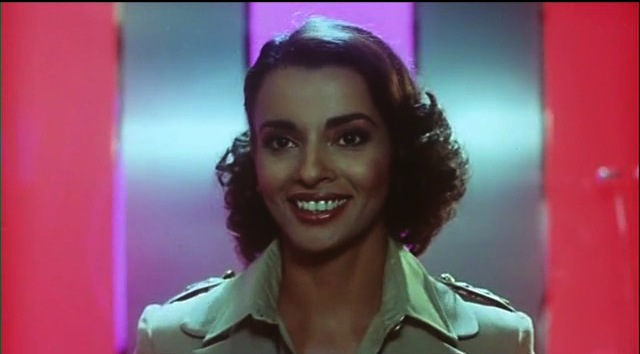 Persis Khambatta (the late Indian actress, best remembered as the bald alien chick in Star Trek: The Motion Picture) is the film’s only significant female presence (which is another reason for some to make the gay subtext argument) and is clearly there because someone reminded Needham there has to be a girl in there somewhere. Her romance with Hunter takes up a large portion of screen time, even though it ultimately goes nowhere.
Persis Khambatta (the late Indian actress, best remembered as the bald alien chick in Star Trek: The Motion Picture) is the film’s only significant female presence (which is another reason for some to make the gay subtext argument) and is clearly there because someone reminded Needham there has to be a girl in there somewhere. Her romance with Hunter takes up a large portion of screen time, even though it ultimately goes nowhere.
As the “villain” Henry Silva isn’t actually allowed to do anything villainous, which kinda sucks the tension out of the movie. The worst thing we seem him do is cheat at chess, which is probably something a typical Needham hero would do in the same situation. The film takes pains to establish that he and Hunter were once friends, and their big scene together is actually the best moment in the movie, but it has no place in a cartoonish action picture where the concepts of good and evil should actually matter. Guerera is very much alive at the end of the movie. When we last see him, he shouts at his escaping friend that they’ll meet each other again.
This is the first clear sign of the obvious fact that Megaforce was intended to become a major franchise, but we’re given absolutely no reason to want to see these two friends/rivals meet again. Especially since we didn’t actually see them do anything here the first time!
That said, Hunter’s escape from Guerera and his tanks results in Megaforce’s most infamous scene, which Needham and Ruddy clearly thought was going to be the most amazing thing anyone had ever witnessed on film. I could spend the next half hour trying to describe it, but I’ll just let you watch it for yourself instead.
So, yeah, that happens. I’d end this here, but special mention also has to be reserved for the film’s final shot, which I admit goes a long way to tearing my “Megaforce isn’t intentionally gay” theory to shreds.
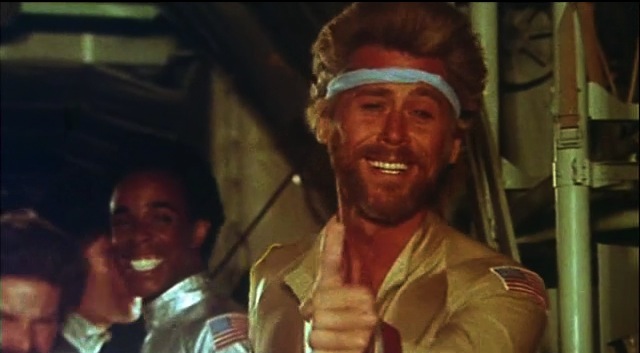
This is how Hal Needham ended his major action opus, folks
Need I say more?


